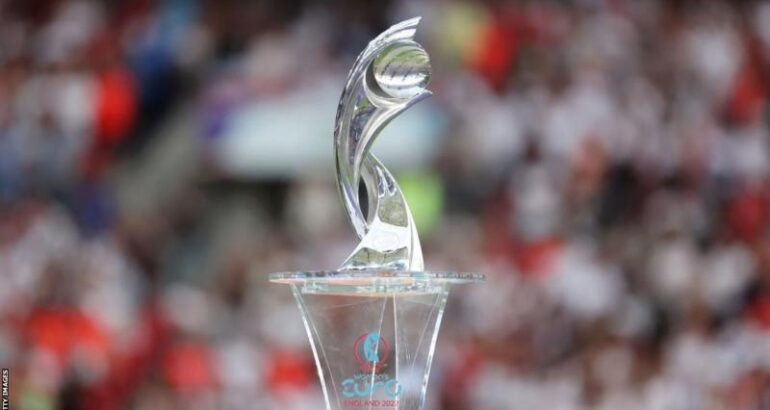European countries will learn their fate in Tuesday’s Women’s Euro 2025 qualifying draw at 12:00 GMT in Nyon.
Of Uefa’s 55 countries, 51 will enter the draw including Switzerland who have automatically qualified for next year’s tournament as the host nation.
Defending champions England are in the draw, hoping to qualify and retain their crown.
Qualifying takes place between April and July.
The new-look format will see 15 teams earn qualification.
BBC Sport explains the draw and looks at who the home nations could face.
How does the draw work?
The 51 teams hoping to qualify for next year’s tournament in Switzerland have been split into three leagues – A, B and C.
Which teams enter which league was determined by the results of the 2023-24 Nations League campaign. Leagues A and B consist of 16 teams, while League C has 19 teams.
In each league, the teams have been split up into four seeding pots.
In Leagues A and B, four groups will be drawn consisting of a team from each pot.
League C has five groups, with only three teams in one of them.
The top two sides from each League A group will automatically qualify for Euro 2025. The remaining seven spots will be decided via play-offs involving the best-ranked sides not to automatically qualify.
The qualifiers, taking place between April and July, will see each team play six games, facing the other teams in their group home and away.
Which pot are teams in and who could home nations face?
Although hosts Switzerland have already qualified for the tournament, they will still enter the draw as one of the top-ranked teams in League B.
Holders England could be drawn in the same group as Republic of Ireland, while Northern Ireland could face either Scotland or Wales in their group.
League A
Pot 1: Spain, France, Germany, Netherlands
Pot 2: England, Denmark, Italy, Austria
Pot 3: Iceland, Belgium, Sweden, Norway
Pot 4: Republic of Ireland, Finland, Poland, Czech Republic
League B
Pot 1: Portugal, Switzerland, Scotland, Wales
Pot 2: Bosnia and Herzegovina, Serbia, Croatia, Hungary
Pot 3: Slovakia, Northern Ireland, Ukraine, Turkey
Pot 4: Malta, Israel, Kosovo, Azerbaijan
League C
Pot 1: Slovakia, Greece, Belarus, Romania, Albania
Pot 2: Latvia, Montenegro, Bulgaria, Estonia, Lithuania
Pot 3: Luxembourg, Kazakhstan, North Macedonia, Cyprus, Andorra
Pot 4: Georgia, Moldova, Faroe Islands, Armenia
Who are in the play-offs?
After the group winners and runners up from each League A group have qualified, the remaining seven places will be taken by the best-ranked sides from all three leagues.
All third and fourth-placed teams from League A will qualify for the play-offs.
The top three teams in each League B group will also make the play-offs. If Switzerland finish in the top three of their group, then the best ranked fourth-place team from League B will qualify for the play-offs.
From League C, the five group winners and three best-ranked runners-up will reach the play-offs.
The 28 teams making the play-offs will be whittled down to seven, with the first round being split into two teams.
The eight sides from League A will be drawn against the eight sides from League C. The six best teams from League B will face the six worst teams from League B. Both sets of matches are two-legged.
In the second play-off round, the 14 teams will be split in seedings. The top seven ranked winners will be drawn against the other seven winners, and the winners of those fixtures will take up the final seven play-off spots.


